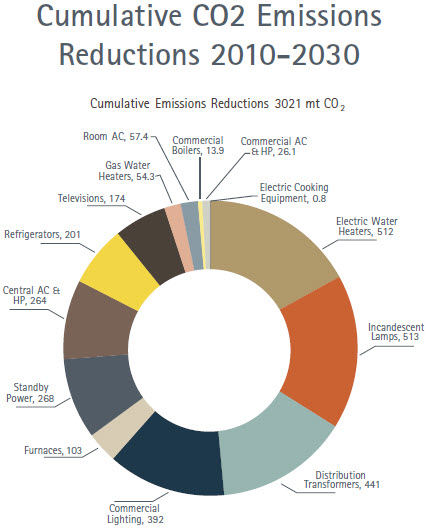![]() Download Full Energy Efficiency Study [PDF - 511 Kb]
Download Full Energy Efficiency Study [PDF - 511 Kb]
![]() Download Study Summary Highlights [PDF - 158 Kb]
Download Study Summary Highlights [PDF - 158 Kb]
It is well-known that energy efficient design contributes to a number of short and long-term societal benefits, including saving fossil fuels and reducing air emissions that cause poor air quality, acid rain and climate change. However, designing and buying products built for efficient use of energy is about more than being a sustainable industry. There is a strong, business case for investing in more energy-efficient products and design.
This work was supported by the International Copper Association through the U.S. Department of Energy.
A 2011 analysis by the Department of Energy concluded that "a significant reduction in energy consumption and emissions is achievable at net negative cost." In other words, encouraging the design and use of energy efficient technologies in the short term (by 2015) will not only have major impacts in the long term (by 2030) on energy use and harmful emissions - such policies will be a profitable investment for consumers.

MAJOR FINDINGS:
By 2030, cost-effective efficiency improvements could save 430 billion total kilowatt hours (kWh) of electricity, which represents about 12 percent of total building electricity consumption, or 9 percent of total electricity consumption in the U.S.
Cumulatively, these improvements will have saved 4,900 billion kWh of electricity and 3.1 exajoules (EJ) of natural gas through 2030. Approximately 85,000 to 200,000 jobs will be created by 2030 due to investments in energy efficient technologies.

In the industrial sector, electric motors are expected to provide the most growth in terms of energy load - and the most potential impact in terms of energy efficient design. Energy savings from electric motors provided through the Energy Independence and Security Act of 2007 are expected to reach approximately 0.15 EJ of natural gas and 8.4 million tons of CO 2 by 2030.
Energy use in commercial building is high, and poised to overtake residential total greenhouse emissions within the next 20 years - with natural gas used in space and water heaters a significant source of CO 2 emissions. Incentivizing energy efficient technologies in this sector will be key.
With most major household appliances already using efficient technologies and with growth in these uses expected to taper, residential growth in energy consumption is expected to be due to increased use of small appliances, consumer electronics and standby power.
Source: " Business Case for Energy Efficiency in Support of Climate Change Mitigation, Economic and Societal Benefits in the United States." Environmental Energy Technologies Division, Ernest Orlando Lawrence Berkeley National Laboratory U.S. Department of Energy. (June 2, 2011.) Report supported by the International Copper Association.
